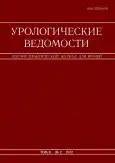Efficiency and tolerability of the anticholinergic therapy in neurogenic bladder overactivity
- Authors: Kuzmin I.V.1, Lukina E.E.1
-
Affiliations:
- St.-Petersburg State I. P. Pavlov Medical University
- Issue: Vol 2, No 2 (2012)
- Pages: 20-25
- Section: Articles
- Submitted: 30.03.2016
- Published: 15.06.2012
- URL: https://journals.eco-vector.com/uroved/article/view/2530
- DOI: https://doi.org/10.17816/uroved2220-25
- ID: 2530
Cite item
Abstract
The treatment of 50 patients with neurogenic bladder overactivity (NBO) (average age 51,8 ± 5,0 years) was carried out. Solifenacine in a dosage of 5 mg per day was proscribed to all patients. The assessment of efficiency and tolerability of treatment was determined by each two weeks from its beginning. As the main criterion of the assessment’s efficiency we used the quantity of imperative desires decreasing of the III–IV degree (on PPIUS questionnaire) more than for 30% from initial level. At an insufficient efficiency the initial dosage of Solifenacine was increased up to 10 mg once per day. In case of insufficiency of the increased Solifenacine dosage, Tolteradine was proscribed additionally in a dosage of 4 mg per day and the treatment was continued. The general duration of treatment of patients was 12 weeks. The performed research results showed of high efficiency and satisfactory acceptability of NBO scheme of treatment. We estimated the treatment’s results of 38 (76,0%) from 50 treated patients as positive. Thus any patients didn't leave the research due to the side effects of treatment development
Full Text
About the authors
Igor Valentinovich Kuzmin
St.-Petersburg State I. P. Pavlov Medical University
Email: kuzminigor@mail.ru
doctor of medical science, professor, Department of Urology
Elena Evgen'evna Lukina
St.-Petersburg State I. P. Pavlov Medical University
Email: luckina.elena@gmail.com
aspirant, Department of Urology
References
- Аль-Шукри С.Х, Кузьмин И. В. Гиперактивность детрузора и ургентное недержание мочи. Пособие для врачей. СПб. 1999. 48 с.
- Аль-Шукри С. Х. Кузьмин И. В. Лукина Е. Е. Медикаментозное лечение больных с нейрогенной гиперактивностью мочевого пузыря // Нефрология. 2012. Т. 16, № 1. С. 57–62.
- Мазо Е. Б., Кривобородов Г. Г., Школьников М. Е., Ефремов Н. С. Ботулинический токсин в лечении урологических заболеваний // Урология. 2007. № 2. С. 76–80.
- Abrams P., Cardozo L., Fall M. et al. The standartisation of terminology in lower urinary tract function: Report from the standartisation sub-committee of the International Continence Society // Neurourol. Urodyn. 2003. Vol. 21. P. 167–178.
- Amend B., Hennenlotter J., Schäfer T. et al. Effective treatment of neurogenic detrusor dysfunction by combined high-dosed antimuscarinics without increased side-effects // Eur Urol. 2008. Vol. 53, № 5. P. 1021–1028.
- Appell R. A. Overactive bladder in special patient populations // Rev. Urol. 2003. Vol. 5, № 8. P. 37–41.
- Braverman A. S., Luthin G. R., Ruggieri M. R. M2 muscarinic receptor contributes to contraction of the denervated rat urinary bladder // Am. J. Physiol. 1998. Vol. 75, № 5. P. 1654– 1660.
- Chancellor M. B., Anderson R. U., Boone T. B. Pharmacotherapy for neurogenic detrusor overactivity // Am. J. Phys. Med. Rehabil. 2006. Vol. 85. P. 536–545.
- Castro-Diaz D., Barrett D., Grise P. et al. Surgery for the neuropathic patient // In: Abrams P., Cardoto L., Khoury S., Wein A., eds. Incontinence: 2st International Consultation on Incontinence, July 1–3, 2002, 2nd ed. Health Publication Ltd, Plymouth, UK. 2002. P. 865–891.
- De Groat W. C. A neurologic basis for the overactive bladder // Urology. 1997. Vol. 50, № 6A Suppl. P. 36–52.
- Diokno A., Ingber M. Oxybutynin in detrusor overactivity // Urol Clin. N. Am. 2006. Vol. 33, № 4. P. 439–445.
- Donnelly J., Hackler R. H., Bunts R. C. Present urologic status of the World War II paraplegic: 25-year follow-up. Comparison with status of the 20-year Korean War paraplegic and 5-year Vietnam paraplegic // J. Urol. 1972. Vol. 108, № 4. P. 558–562.
- Eglen R. M., Hegde S., Watson N. Muscarinic receptor subtypes and smooth muscle function // Pharmacol. Rev. 1996. Vol. 48. P. 531–565.
- Fowler C. J. Investigation of the neurogenic bladder // J. Neurol. Neurosurg. Psychiatry. 1996. Vol. 60, № 1. P. 6–13.
- Game X., Karsenty G., Chartier-Kastler E., Ruffion A. Treatment of neurogenic detrusor hyperactivity: enterocystoplasty // Neurourol. Urodyn. 2011. Vol. 30, № 3. P. 395–401.
- Menarini M., Del Popolo G., Di Benedetto P. et al. Trospium chloride in patients with neurogenic detrusor overactivity: is dose titration of benefit to the patients? // Int. J. Clin. Pharmacol. Ther. 2006. Vol. 44, № 12. P. 623–632.
- O’Leary M., Erickson J. R., Smith C. P. et al. Effect of controlled release oxybutynin on neurogenic bladder function in spinal cord injury // J. Spinal. Cord. Med. 2003. Vol. 26, № 2. P. 159–162.
- Rajkumar G. N., Conn I. G. Botulinum toxin: a new dimension in the treatment of lower urinary tract dysfunction // Urology. 2004. Vol. 64, № 1. P. 2–8.
- Stöhrer М., Blok B., Castro-Diaz D. et al. EAU Guidelines on Neurogenic Lower Urinary Tract Dysfunction // Eur. Urol. 2009. Vol. 56, № 1. P. 81–88.
Supplementary files









